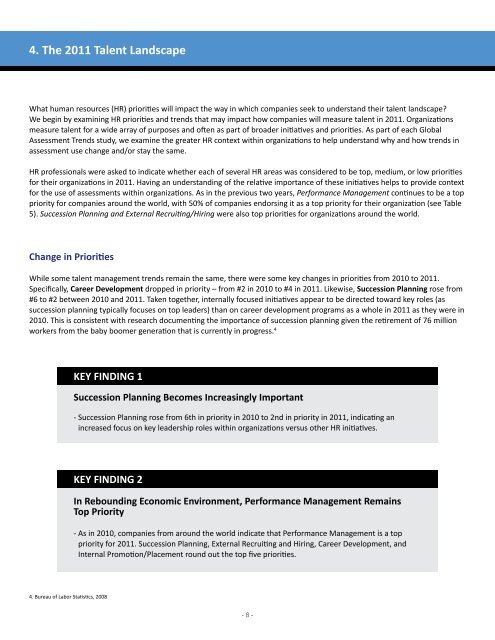Research Report
Research report
Research report
Create successful ePaper yourself
Turn your PDF publications into a flip-book with our unique Google optimized e-Paper software.
4. The 2011 Talent Landscape<br />
What human resources (HR) priorities will impact the way in which companies seek to understand their talent landscape?<br />
We begin by examining HR priorities and trends that may impact how companies will measure talent in 2011. Organizations<br />
measure talent for a wide array of purposes and often as part of broader initiatives and priorities. As part of each Global<br />
Assessment Trends study, we examine the greater HR context within organizations to help understand why and how trends in<br />
assessment use change and/or stay the same.<br />
HR professionals were asked to indicate whether each of several HR areas was considered to be top, medium, or low priorities<br />
for their organizations in 2011. Having an understanding of the relative importance of these initiatives helps to provide context<br />
for the use of assessments within organizations. As in the previous two years, Performance Management continues to be a top<br />
priority for companies around the world, with 50% of companies endorsing it as a top priority for their organization (see Table<br />
5). Succession Planning and External Recruiting/Hiring were also top priorities for organizations around the world.<br />
Change in Priorities<br />
While some talent management trends remain the same, there were some key changes in priorities from 2010 to 2011.<br />
Specifically, Career Development dropped in priority – from #2 in 2010 to #4 in 2011. Likewise, Succession Planning rose from<br />
#6 to #2 between 2010 and 2011. Taken together, internally focused initiatives appear to be directed toward key roles (as<br />
succession planning typically focuses on top leaders) than on career development programs as a whole in 2011 as they were in<br />
2010. This is consistent with research documenting the importance of succession planning given the retirement of 76 million<br />
workers from the baby boomer generation that is currently in progress. 4<br />
KEY FINDING 1<br />
Succession Planning Becomes Increasingly Important<br />
- Succession Planning rose from 6th in priority in 2010 to 2nd in priority in 2011, indicating an<br />
increased focus on key leadership roles within organizations versus other HR initiatives.<br />
KEY FINDING 2<br />
4. Bureau of Labor Statistics, 2008<br />
In Rebounding Economic Environment, Performance Management Remains<br />
Top Priority<br />
- As in 2010, companies from around the world indicate that Performance Management is a top<br />
priority for 2011. Succession Planning, External Recruiting and Hiring, Career Development, and<br />
Internal Promotion/Placement round out the top five priorities.<br />
- 8 -



